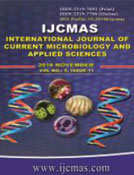


 National Academy of Agricultural Sciences (NAAS)
National Academy of Agricultural Sciences (NAAS)

|
PRINT ISSN : 2319-7692
Online ISSN : 2319-7706 Issues : 12 per year Publisher : Excellent Publishers Email : editorijcmas@gmail.com / submit@ijcmas.com Editor-in-chief: Dr.M.Prakash Index Copernicus ICV 2018: 95.39 NAAS RATING 2020: 5.38 |
This study aimed to investigate the prevalence of Multidrug resistant Acinetobacter baumannii (MDR-AB) as a cause of health-care associated infection (HAI) in cancer patients and study the mechanisms of carbapenem resistance in relation to different risk factors. In this study, Multidrug resistant Acinetobacter were isolated and subjected to Imipenem-EDTA combined disk synergy (CDST-IPM), multiplex PCR to detect four families of OXA-type carbapenamases and sequencing of blaOXA-51 like gene. During one and a half year, MDR-AB accounted for 15% of gram negative pathogens. The majority of MDR-AB infections were in patients who spent 7 or more days in the hospital (76.8%). More than one mechanism of resistance were detected, as metallo-β-lactamase (MBL) producers, blaOXA-51 like and blaOXA-23 like were detected in 80%, 94% and 63% of MDR-AB; respectively. The blaOXA-23 and MBLs coexisted simultaneously in 71% of cases (p=0.003); and 7% of imipenem resistant isolates were negative for MBL and blaOXA-23 suggesting other resistance mechanisms. The presence of Acinetobacter resistant genes (blaOXA-51 and blaOXA-23) was significantly associated with carbapenem use, p=0.015 and 0.064; respectively. The phylogenetic analysis showed different genetic variants. In conclusion, acquisition of carbapenem resistance among MDR-AB could be related to carbapenem therapy and prolonged duration of hospitalization.
 |
 |
 |
 |
 |